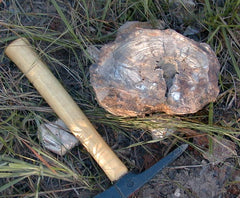There's almost nothing any rockhound enjoys more than finding "treasure" hidden deep beneath the ground!! We're blessed to be in the Pacific Northwest, where some of the best and most famous collectible stones and petrified wood are found!
Of course, to get the best stuff you have to work very hard which often means many hours spent in a hole to come up with a few choice stones - or not. Here are a few photos of some of our field trips.
Friend's Ranch, Oregon:

A very large thunderegg pit on the Friend's Ranch near Ashwood, Oregon. Those are 55 gallon drums down there! The thundereggs in this bed are somewhat unique in the area. There are many thunderegg beds within just a few miles of this mine, but the others all tend to be similar (more or less) to the famous Blue Bed eggs on the Richardson's Ranch. The Friends eggs don't have much in common with any of these, but they remain one of my favorites!

To get the best stones you have to get deep enough into the hill to reach the soil that doesn't freeze over the winter. Freezing is one reason so many thundereggs have undesirable fractures. We spent two days in this dig recently and mined some incredibly nice eggs. You can see a pair of eggs in the wall just above my hands. It's important to dig as much of the soil out from around them as you can before "popping" them loose to avoid damaging the egg.
Marston Ranch, Oregon:

One of the most colorful materials in Oregon is the pastel jasper found in an ever deepening pit on the Marston Ranch near Ashwood, Oregon. This material forms in a seam that is often a foot or more thick. It's principal colors are red, green and gold - but you can find just about every pastel shade in between in the best pieces. Many people believe that this is a petrified bog of some sort, and the limb shaped intrusions near the edges, as well as the scalloped plumy edges that look like algae, tend to support this observation - but I don't know of anyone who can say for certain.
The pit is worked almost exclusively by the the owner, John Marston, and his very large bulldozer. He moves several tons of overburden per scoop working about 15 feet below the surface to pull big "chunks" of the prized jasp-agate from the seam.

The pit is quite large and unsafe for hand tools. The overburden is very loose stone that appears to be a fractured up wall of perlite or some related rock formation. It comes tumbling down like un-mortared bricks and could easily kill those foolish enough to turn their back. I'm posing here well away from the wall. The agate is found at about the level my hat is at.
Tocantins, Brazil:

My first find in Brazil! It's a nice solid log that, judging by the hollow star in the center, could well be Dadoxylon - but we won't know for sure until it's cut and polished.